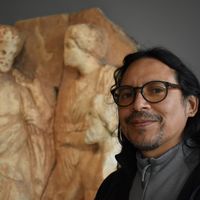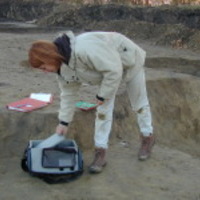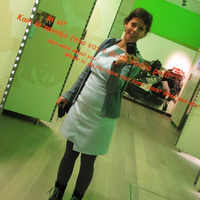
Branden Rizzuto
Branden Rizzuto is a PhD Student in Archaeology at the University of Toronto with research interests in archaeological sciences (particularly archaeometallurgy and obsidian sourcing), the archaeology of technology, the archaeology of ritual, and the archaeology of pre-Hispanic Andean cultures.
Branden was born in Timmins, Ontario, Canada and graduated from the University of Toronto in 2014 with a Bachelor of Science (Hons.) in both archaeological sciences and chemistry. He began graduate studies the same year, graduating from University College London in 2015 with a Master of Science in the Technology and Analysis of Archaeological Materials, soon after beginning his PhD in Archaeology at the University of Toronto.
Under the joint supervision of John Merkel and Marcos Martinón-Torres, Branden's masters dissertation focused on using archaeometric methods to characterize the material flow-paths of raw materials and metal alloys in the Batán Grande region of Peru during the Middle Sicán (900 - 1100 CE) period, with particular emphasis on the production of 'naipes' (thin, I-shaped sheets of arsenic bronze) by Middle Sicán artisans. Under the joint supervision of Edward Swenson and Edward Banning, Branden is currently conducting his PhD research on the origins and early development of arsenic bronze technologies on the North Coast of Peru during the Middle Horizon (600 - 1000 CE) period, with particular emphasis on diachronic studies of the organization, social relations, and production strategies associated with these technologies, as well as the relationship between these technologies and the shifting socio-political and ritual landscapes in the region during the Middle Horizon period.
Since 2010, Branden Rizzuto has conducted fieldwork in the Jequetepeque Valley on the North Coast of Peru as part of the Proyecto Jatanca-Huaca Colorada co-directed by Edward Swenson and Francisco Seoane. He also conducts archaeometric research in collaboration with the Sicán Archaeological Project (Lambayeque-La Leche Valley, Peru), and Proyecto de Investigación Arqueológica Quilcapampa la Antigua (Valle de Siguas, Arequipa, Peru).
Supervisors: Edward Swenson and Edward Banning
Branden was born in Timmins, Ontario, Canada and graduated from the University of Toronto in 2014 with a Bachelor of Science (Hons.) in both archaeological sciences and chemistry. He began graduate studies the same year, graduating from University College London in 2015 with a Master of Science in the Technology and Analysis of Archaeological Materials, soon after beginning his PhD in Archaeology at the University of Toronto.
Under the joint supervision of John Merkel and Marcos Martinón-Torres, Branden's masters dissertation focused on using archaeometric methods to characterize the material flow-paths of raw materials and metal alloys in the Batán Grande region of Peru during the Middle Sicán (900 - 1100 CE) period, with particular emphasis on the production of 'naipes' (thin, I-shaped sheets of arsenic bronze) by Middle Sicán artisans. Under the joint supervision of Edward Swenson and Edward Banning, Branden is currently conducting his PhD research on the origins and early development of arsenic bronze technologies on the North Coast of Peru during the Middle Horizon (600 - 1000 CE) period, with particular emphasis on diachronic studies of the organization, social relations, and production strategies associated with these technologies, as well as the relationship between these technologies and the shifting socio-political and ritual landscapes in the region during the Middle Horizon period.
Since 2010, Branden Rizzuto has conducted fieldwork in the Jequetepeque Valley on the North Coast of Peru as part of the Proyecto Jatanca-Huaca Colorada co-directed by Edward Swenson and Francisco Seoane. He also conducts archaeometric research in collaboration with the Sicán Archaeological Project (Lambayeque-La Leche Valley, Peru), and Proyecto de Investigación Arqueológica Quilcapampa la Antigua (Valle de Siguas, Arequipa, Peru).
Supervisors: Edward Swenson and Edward Banning
less
Related Authors
Go Matsumoto
Yamagata University
Tristan Carter
McMaster University
Henry Tantaleán
Universidad Nacional Mayor de San Marcos
Miljana Radivojević
University College London
Enrico Cirelli
Università di Bologna
Lesley D. Frame
University of Connecticut
Michael Dietler
University of Chicago
Viktória Kiss
Hungarian Academy of Sciences
Gary Feinman
Field Museum
Selena Vitezović
Institute of Archaeology, Belgrade, Serbia
InterestsView All (25)









Uploads
Papers by Branden Rizzuto
Conference Posters by Branden Rizzuto
The site of Castillo de Huarmey, located on the north coast of Peru and dated to the Middle Horizon period (650-1050 CE), is widely known for an important discovery of the first undisturbed Wari royal mausoleum. With multiple burials, rich ceremonial offerings, and a wealth of grave goods, the assemblage embraces a diversity of artistic, iconographic, and technological craft traditions which represent a plethora of Central Andean cultural backgrounds. In 2018 a new primary burial context was discovered which contained the preserved remains of a young male individual with an intriguing set of copper and bronze objects, an argentiferous lead ingot, and metallurgical byproducts such as slag and speiss. The following poster presents an archaeometric and archaeological comparison of the metallurgical materials discovered in both this newly discovered tomb and the royal mausoleum at Castillo de Huarmey. The results indicate that associated craft artisans employed a variety of technological strategies to produce an eclectic mix of copper, arsenic bronze, silver, and gold objects with differing chemical compositions and material properties. These results shed further light on early Middle Horizon metallurgical technologies within the Central Andes, including early arsenic bronze technologies on the North Coast of Peru.
As one of the earliest alloys of the ancient world, the study of the production and use of arsenic bronze is of significant interest to archaeometallurgists and archaeologists alike. However, archaeometric investigations of ancient arsenic bronze alloys and artefacts have been hampered by a lack of available reference standards, with only three arsenic bronze reference standards having been commercially produced to date: BCR-691 C, MBH-36XCUAS3 A, and MBH-36XCUAS4 A [1]. Additionally, the fabrication of arsenic bronze alloys analytically suitable for use as reference standards is complicated by segregation processes which take place in these alloys during the casting and cooling stages of manufacture [2]. This poster presents the preliminary results of ongoing efforts to create new arsenic bronze reference standards through the use of graphite mold casting, slow cooling, and prolonged annealing techniques under reducing conditions. Using these fabrication techniques, it is possible to fabricate arsenic bronze alloys of sufficient homogeneity for use as reference standards for chemical analysis. It is the intention of the authors to use these techniques to fabricate a suite of reference standards which would provide new opportunities for interlaboratory collaborations and comparative research on arsenic bronze alloys and artefacts.
[1] Heginbotham, A., Bassett, J., Bourgarit, D., Eveleigh, C., Glinsman, L., Hook, D., Smith, D., Speakman, R., Shugar, A., and Van Langh, R., 2014, The Copper CHARM Set: A New Set of Certified Reference Materials for the Standardization of Quantitative X-Ray Fluorescence Analysis of Heritage Copper Alloys, Archaeometry, 57(5), 856-868.
[2] Mödlinger, M., and Sabatini, B., 2016, A Re-evaluation of inverse segregation in prehistoric As-Cu objects, Journal of Archaeological Science, 74, 60-74.
This poster highlights emerging results of our ongoing study to further characterize the procurement networks and use strategies of obsidian sources in the south-central Andes during the Middle Horizon (600 CE – 1000 CE) and Late Intermediate Periods (1000 CE – 1476 CE). We present archaeometric analyses and provenience studies of excavated obsidian objects from the Middle Horizon – Late Intermediate site of Quilcapampa, located in the Valle de Siguas, Arequipa, Peru. In total, 70 objects were analyzed using handheld energy-dispersive x-ray fluorescence spectrometry (pXRF). Preliminary results demonstrate that the obsidian used at Quilcapampa originates from several distinct outcrop sources within the central Andean region, and particular attention is given to how obsidian procurement practices at Quilcapampa varied over time.
The site of Castillo de Huarmey, located on the north coast of Peru and dated to the Middle Horizon period (650-1050 CE), is widely known for an important discovery of the first undisturbed Wari royal mausoleum. With multiple burials, rich ceremonial offerings, and a wealth of grave goods, the assemblage embraces a diversity of artistic, iconographic, and technological craft traditions which represent a plethora of Central Andean cultural backgrounds. In 2018 a new primary burial context was discovered which contained the preserved remains of a young male individual with an intriguing set of copper and bronze objects, an argentiferous lead ingot, and metallurgical byproducts such as slag and speiss. The following poster presents an archaeometric and archaeological comparison of the metallurgical materials discovered in both this newly discovered tomb and the royal mausoleum at Castillo de Huarmey. The results indicate that associated craft artisans employed a variety of technological strategies to produce an eclectic mix of copper, arsenic bronze, silver, and gold objects with differing chemical compositions and material properties. These results shed further light on early Middle Horizon metallurgical technologies within the Central Andes, including early arsenic bronze technologies on the North Coast of Peru.
As one of the earliest alloys of the ancient world, the study of the production and use of arsenic bronze is of significant interest to archaeometallurgists and archaeologists alike. However, archaeometric investigations of ancient arsenic bronze alloys and artefacts have been hampered by a lack of available reference standards, with only three arsenic bronze reference standards having been commercially produced to date: BCR-691 C, MBH-36XCUAS3 A, and MBH-36XCUAS4 A [1]. Additionally, the fabrication of arsenic bronze alloys analytically suitable for use as reference standards is complicated by segregation processes which take place in these alloys during the casting and cooling stages of manufacture [2]. This poster presents the preliminary results of ongoing efforts to create new arsenic bronze reference standards through the use of graphite mold casting, slow cooling, and prolonged annealing techniques under reducing conditions. Using these fabrication techniques, it is possible to fabricate arsenic bronze alloys of sufficient homogeneity for use as reference standards for chemical analysis. It is the intention of the authors to use these techniques to fabricate a suite of reference standards which would provide new opportunities for interlaboratory collaborations and comparative research on arsenic bronze alloys and artefacts.
[1] Heginbotham, A., Bassett, J., Bourgarit, D., Eveleigh, C., Glinsman, L., Hook, D., Smith, D., Speakman, R., Shugar, A., and Van Langh, R., 2014, The Copper CHARM Set: A New Set of Certified Reference Materials for the Standardization of Quantitative X-Ray Fluorescence Analysis of Heritage Copper Alloys, Archaeometry, 57(5), 856-868.
[2] Mödlinger, M., and Sabatini, B., 2016, A Re-evaluation of inverse segregation in prehistoric As-Cu objects, Journal of Archaeological Science, 74, 60-74.
This poster highlights emerging results of our ongoing study to further characterize the procurement networks and use strategies of obsidian sources in the south-central Andes during the Middle Horizon (600 CE – 1000 CE) and Late Intermediate Periods (1000 CE – 1476 CE). We present archaeometric analyses and provenience studies of excavated obsidian objects from the Middle Horizon – Late Intermediate site of Quilcapampa, located in the Valle de Siguas, Arequipa, Peru. In total, 70 objects were analyzed using handheld energy-dispersive x-ray fluorescence spectrometry (pXRF). Preliminary results demonstrate that the obsidian used at Quilcapampa originates from several distinct outcrop sources within the central Andean region, and particular attention is given to how obsidian procurement practices at Quilcapampa varied over time.